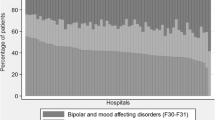Abstract
Background
Acute psychiatric admissions lasting over 6 months (long-stays) continue to occur in England. Previous studies have suggested an association between long-stay and both schizophrenia and challenging behaviour, as well as rehousing or placement difficulties, but no UK study to date has compared such cases with control admissions.
Methods
We performed a case–control study. All long-stay patients present on acute general psychiatric wards serving the London Boroughs of Croydon, Lambeth, Lewisham and Southwark on November 1st 2004 were compared with a group of ‘next admitted’ controls. We followed up long-stay cases 1 year later to determine whether they were still in hospital, and, if not, where they were living.
Results
In unadjusted comparisons long stay was associated with schizophrenia, non-white ethnicity, admission not due to suicidality, violence, severe illness and need for rehousing. A logistic regression was used to adjust for associations among exposures and only violence, severity of illness and need for rehousing remained associated with long-stay. After 1 year, two-thirds of cases were living out of hospital.
Conclusions
Case–control studies may usefully contribute to the study of the complex social phenomenon of long-stay. Further research should address how the combination of individual and socially-determined effects that we found operate together over the course of admission to generate long-stays.
Similar content being viewed by others
References
Bland JM, Altman DG (1994) Matching. Br Med J 309(6962):1128
Brock IP, Brown GR (1993) Psychiatric length of stay determinants in a military medical center. Gen Hosp Psychiatry 15:392–398
Brown TM, Miller HL, Ekstrom D, Evans DL, Golden RN (1991) Characteristics of long-stay patients on the psychiatric service of a university hospital. Hosp Community Psychiatry 42(7):743–745
Cowan C, Walker P (2005) New long-stay patients in a psychiatric admission ward setting. Psychol Bull 29:452–454
Creed F, Tomenson B, Anthony P, Tramner M (1997) Predicting length of stay in psychiatry. Psychol Med 27:961–966
Folstein MF, Folstein SE, McHugh PR (1975) “Mini-mental state”. A practical method for grading the cognitive state of patients for the clinician. J Psychiatr Res 12(3):189–198
Grassi L, Biancosino B, Marmai L et al (2006) Violence in psychiatric units: a 7 year Italian study of persistently assaultive patients. Soc Psychiatry Psychiatr Epidemiol 41(9):698–703
Greenfield TK, McNiel DE, Binder RL (1989) Violent behaviour and length of psychiatric hospitalisation. Hosp Community Psychiatry 40(8):809–814
Hodgson RE, Lewis M, Boardman J (2000) The prediction of in-patient length of stay for acute psychiatric admissions. J Ment Health 9(2):145–153
Holloway F, Wykes T, Petch E, Lewis-Cole K (1999) The new long-stay in an inner-city service: a tale of two cohorts. Int J Soc Psychiatry 45:93–103
Huntley DA, Cho DW, Christman J, Csemansky JG (1998) Predicting length of stay in an acute psychiatric hospital. Psychiatr Serv 49:1049–1053
Jakubaschk J, Kopp W (1989) On characterising new psychiatric long-stay patients. Soc Psychiatry Psychiatr Epidemiol 24:88–95
Jakubaschk J, Waldvogel D, Wurmle O (1993) Differences between long-stay and short-stay inpatients and estimation of length of stay. Soc Psychiatry Psychiatr Epidemiol 28:84–90
Katz MH (2006) Multivariable analysis: a practical guide for clinicians, 2nd edn. Cambridge University Press, New York
Keown P, Holloway F, Kuipers E (2005) The impact of severe mental illness, co-morbid personality disorders and demographic factors on psychiatric bed-use. Soc Psychiatry Psychiatr Epidemiol 40(1):42–49
Lelliott P, Wing J, Clifford P (1994a) A national audit of new long-stay psychiatric patients. I: method and description of the cohort. Br J Psychiatry 165:160–169
Lelliott P, Wing J, Clifford P (1994b) A national audit of new long-stay psychiatric patients. II: impact on services. Br J Psychiatry 165:170–178
McCrone P, Phelan M (1994) Diagnosis and length of psychiatric in-patient stay. Psychol Med 24(4):1025–1030
Mann SA, Cree W (1976) “New” long-stay psychiatric patients: a national sample survey of fifteen mental hospitals in England and Wales 1972/3. Psychol Med 6(4):603–616
Moran P, Leese M, Lee T, Walters P, Thornicroft G (2003) Standardised assessment of personality—abbreviated scale (SAPAS): preliminary validation of a brief screen for personality disorder. Br J Psychiatry 183:228–232
McGuffin P, Farmer A, Harvey I (1991) A polydiagnostic application of operational criteria in studies of psychotic illness: development and reliability of the OPCRIT system. Arch Gen Psychiatry 48:764–770
O’Carroll RE (1987) The inter-rater reliability of the national adult reading test (NART): a pilot study. Br J Clin Psychol 26(3):229–230
Ries RK, Russo J, Wingerson D, Snowden M, Comtois KA, Srebnik D, Roy-Byrne P (2000) Shorter hospital stays and more rapid improvement among patients with schizophrenia and substance disorders. Psychiatr Serv 51(2):210–215
Saeed H, Ouellette-Kuntz H, Stuart H, Burge P (2003) Length of stay for psychiatric inpatient services: a comparison of admissions of people with and without developmental disabilities. J Behav Health Serv Res 30:406–417
Thompson A, Shaw M, Harrison G, Ho D, Gunnell D, Verne J (2004) Patterns of hospital admission for adult psychiatric illness in England: analysis of hospital episode statistics data. Br J Psychiatry 185:334–341
Wykes T, Sturt E (1986) The measurement of social behaviour in psychiatric patients: an assessment of the reliability and validity of the social behaviour schedule. Br J Psychiatry 148:1–11
Acknowledgements
The study was funded by the research and development fund of South London and Maudsley NHS Trust. Kyle DeBarry of the South London and Maudsley NHS Trust’s IT department coordinated the extraction of data from computerised databases and provided valuable assistance in developing algorithms for case and control finding. We are grateful for the assistance of those service users and staff who contributed to the study. The authors have no competing interests.
Author information
Authors and Affiliations
Rights and permissions
About this article
Cite this article
Tulloch, A.D., Fearon, P. & David, A.S. The determinants and outcomes of long-stay psychiatric admissions. Soc Psychiat Epidemiol 43, 569–574 (2008). https://doi.org/10.1007/s00127-008-0332-2
Received:
Accepted:
Published:
Issue Date:
DOI: https://doi.org/10.1007/s00127-008-0332-2



